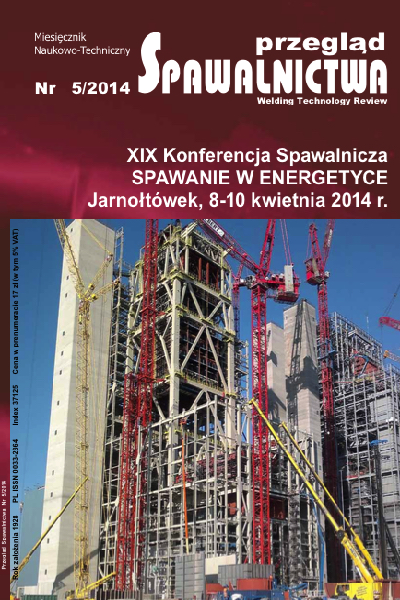Mikrostruktura i właściwości mechaniczne złącza spawanego stali 12HMF po długotrwałej eksploatacji; Microstructure and mechanical properties of welded joint of 12HMF steel after long-term service
##plugins.themes.bootstrap3.article.main##
Abstrakt
W pracy przedstawiono wyniki badań mikrostruktury i właściwości mechanicznych złącza spawanego stali 12HMF. Badany materiał pobrany został z rurociągu z obwodowym złączem spawanym po długotrwałej eksploatacji w temperaturze 490oC, ciśnieniu pary 8 MPa i czasie pracy 419 988 godzin. Przeprowadzone badania wykazały, że materiał rodzimy (stal 12HMF) charakteryzuje się po eksploatacji typową dla tego gatunku stali mikrostrukturą ferrytyczno-bainityczną z dominującym udziałem ferrytu quasipoligonalnego. W spoinie obserwo- wano mikrostrukturę bainityczną z pojedynczymi ziarnami ferrytu, natomiast mikrostruktura strefy wpływu ciepła była zróżnicowana: od bainitycznej w pobliżu linii wtopienia do drobnoziarnistej ferrytycznobanitycznej. Badania właściwości mechanicznych wykazały, że materiał rodzimy i spoina charakteryzowały się bardzo niską udarnością KV. Materiał rodzimy charakteryzował się również niższą od wymaganego minimum granicą plastyczności. Przeprowadzone badania wskazują, że główną przyczy- ną degradacji mikrostruktury badanego złącza były: wydzielanie i koagulacja węglików M2C, powstawanie stref przygranicznych zubożonych w wydzielenia oraz segregacja fosforu do granic ziaren.
Abstract
The paper presents the results of research on the microstructure and mechanical properties of a welded joint after long-term service. The investigated material was taken from a pipeline with circumferential welded joint after 419 988 h of service at the temperature of 490 oC and steam pressure of 8 MPa. Performed research has shown that the native material (12HMF steel) after service is characterized by a typical microstructure for this grade of steel, i.e. ferritic-bainitic microstructure with dominant amount of quasipolygonal ferrite. In the weld, however, a bainitic microstructure with single grains of ferrite was observed. Whilst the microstructure of the heat-affected zone was diverse: from the bainitic one near the line of fusion, to the fine-grained ferritic-bainitic one. The investigation of the properties has proved that the native mate- rial and the weld are characterized by very low impact strength KV. The native material was also characterized by the yield strength lower that the required minimum. Performed tests also show that the main causes of deg- radation of the microstructure of the examined joint were: precipitation and coagulation of M2C carbides, formation of precipitate depleted zones near the boundaries and segregation of phosphorus to grain boundaries.
Pobrania
##plugins.themes.bootstrap3.article.details##
Creative Commons CC BY 4.0 https://creativecommons.org/licenses/by/4.0/
Artykuły czasopisma Welding Technology Review (Przegląd Spawalnictwa) publikowane są w otwartym dostępie na licencji CC BY (licencja Creative Commons Uznanie autorstwa 4.0 Międzynarodowe). Licencja CC BY jest najbardziej otwartą dostępną licencją i uważaną za „złoty standard” w formule otwartego dostępu; jest również preferowany przez wielu fundatorów badań. Licencja ta umożliwia czytelnikom kopiowanie i redystrybucję materiału na dowolnym nośniku i w dowolnym formacie, a także zmienianie, przekształcanie lub budowanie na nim materiału, w tym do użytku komercyjnego, pod warunkiem wskazania oryginalnego autora.
Bibliografia
A. Zieliński, J. Dobrzański, M. Dziuba-Kałuża: Structure of welded joints of 14MoV6-3 and 13CrMo4-5 steel elements after design work time under creep conditions, Archiv. Mater. Sc. Eng., 61/2, 2013, 69÷76
S. Stachura: Zmiany struktury i właściwości mechanicznych w stalach i staliwach eksploatowanych w podwyższonych temperaturach, Energetyka, 2, 1999, 109÷115
A. Zieliński, J. Dobrzański: Ocena stanu i przydatności do dalszej pracy materiału rurociągów parowych eksploatowanych powyżej obliczeniowego czasu pracy, Prace IMŻ, 3, 2013, s. 42÷55
A. Jasiński: Wydłużona eksploatacja krajowych bloków energetycznych szanse i zagrożenia, Energetyka, 3, 2013, 551÷556
J. Dobrzański, A. Zieliński, H. Paszkowska: Wyznaczanie trwałości resztkowej i czasu dalszej bezpiecznej pracy na przykładzie materiału rodzimego i złącza spawanego, Prace IMŻ, 1, 2009, 9÷25
PN-75/H-84024 Stal do pracy przy podwyższonych temperaturach. Gatunki
PN-EN ISO 643:2012 Stal. Mikrograficzne określanie wielkości ziarna.
A. Joarder, D. S. Sarma, n. S. Cheruvu: Effect of long term service exposure on microstructure and mechanical properties of a CrMoV steam turbine rotor steel, Metall. Trans., 22A, 1991, 1811÷1820
N.S. Cheruvu: Degradation of mechanical properties of Cr- Mo-V and 2.25Cr-1Mo steel components after long-term service at elevated temperatures, Metall. Trans., 20A, 1989, 87÷97
J. Janovec, M. Svoboda, A. Kroupa, A. Vyrostkova: Thermal-induced evolution of secondary phases in CrMoV low alloy steels, J. Mater. Sci., 41, 2006, 3425÷3433
A. Vyrostkova, A. Kroupa, J. Janovec, M. Svoboda: Carbide reactions and phase equilibria in low alloy Cr-Mo-V steels tempered at 773-993K. Part I: Experimental measurements, Acta mater., 46, 1, 1998, 31÷58
R.D. Fu, T.S. Wang, W.H. Zhou, W.H. Zhangc, F.C. Zhang: Characterization of precipitates in a 2.25Cr1Mo0.25V steel for large-scale cast-forged products, Mater. Character., 58, 2007, 968÷973
G. D. Pigrova: Effect of long term operation on carbide phases in CrMoV steels, Metal Sc. Heat Treat., 45, 3-4, 2003, 84÷87
B. A. Senior: A critical review of precipitation behavior in 1CrMoV rotor steels, Mater. Sc. Eng. A, 103, 1988, 263÷271
G. Golański, P. Wieczorek: Precipitation of carbides in Cr- Mo-V cast steel after service and regenerative heat treatment, Arch. Found. Eng., 9, 1, 2009, 97÷102
R. M. Horn, R.O. Ritchie: Mechanism of tempered martensite embrittlement in low alloy steels, Metall. Trans. A, 9A, 1978, 1039÷1053
Z. Qu, K. H. Kuo: Embrittlement of 21â„4 CrMoV steel bolts after long exposure at 540°C, Metall. Trans., 12A, 1981, 1333÷1337
M. A. Islam, M. novovic, P. Bowen, J.F. Knott: Effect of phosphorus segregation on fracture properties of 2.25Cr-1Mo pressure vessel steel, J. Mater. Eng. Perform., 12 (3), 2003, 244÷248
S. Stachura. Z. Stradomski, G. Golański: Fosfor w stopach żelaza, Hutnik Wiadomości Hutnicze, 5, 2001, 184÷193
H. Erhart, H. J. Grabke: Equilibrium segregation of phosphorus at grain boundaries of Fe-P, Fe-C-P, Fe-Cr-P and Fe-Cr- C-P alloys, Metal Sc., 15, 1981, 401÷408
A. Zieliński, J. Dobrzański, H. Krztoń: Structural changes in low alloy cast steel Cr-Mo-V after long time creep service, J. Achiev. Mater. Manuf. Eng., 25/ 1, 2007, 33÷36
